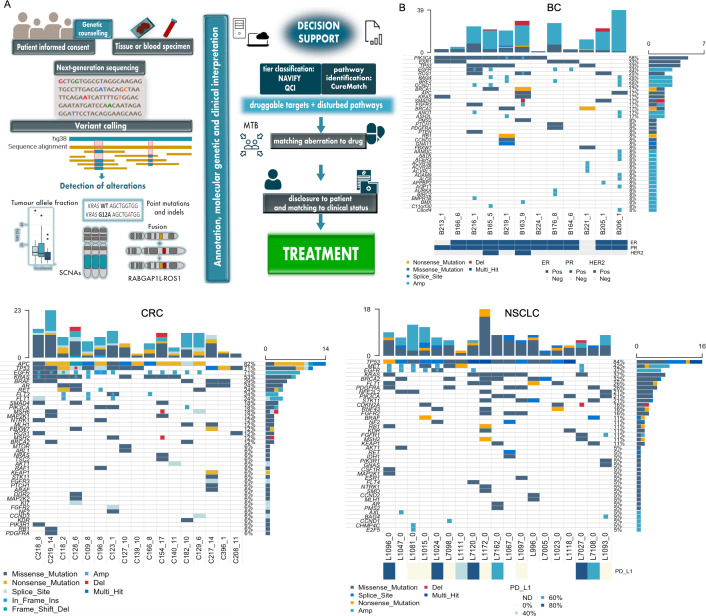Figure 1.
Steps involved in precision oncology and summary of molecular profiling data. (A) Cascade of individual steps involved in precision oncology: due to the increasingly extensive sequencing involved in precision oncology, genetic counselling may be required and an informed consent needs to be obtained in every case. Sequencing can be conducted with a tissue sample and/or from blood after isolation of plasma DNA, the latter being the specimen used in our study. Subsequently, various sequencing strategies can be applied to the sample to determine tumour AF and to detect alterations such as SNVs (point mutations) and indels, SCNAs and fusions. A decisive step in precision oncology is variant annotation, the molecular and clinical interpretation of targets and matching these with drugs. In this study, the data were subjected to interpretation by three clinical decision support tools (NAVIFY, QCI, CureMatch) to obtain treatment possibilities. The multidisciplinary MTB evaluates the data and gives advice to the treating physician. Afterwards, the results are disclosed to the patient and matched to their clinical status and, if applicable, the treatment is started. These last two steps were not within the scope of our retrospective study. (B) Oncoplots showing top 40 genes affected by mutation (ie, SNV or indel) and/or SCNA identified in plasma DNA for patients with BC (left), CRC (centre) and NSCLC (right). SCNAs are represented by either focal amplification (Amp) or focal deletion (Del). For patients with BC, hormone receptor status is shown as a clinical feature below the plot for each patient (ER, PR, HER2) as either positive (Pos) or negative (Neg). Similarly, if evaluated, PD-L1 expression status is shown as a clinical feature below the plot for patients with NSCLC as a per cent. AF, allele fraction; ER, oestrogen receptor; HER2, human epidermal growth factor receptor 2; ND, not detected; NSCLC, non-small-cell lung cancer; PR, progesterone receptor; QCI, QIAGEN Clinical Insight; SNV, single nucleotide variant.

